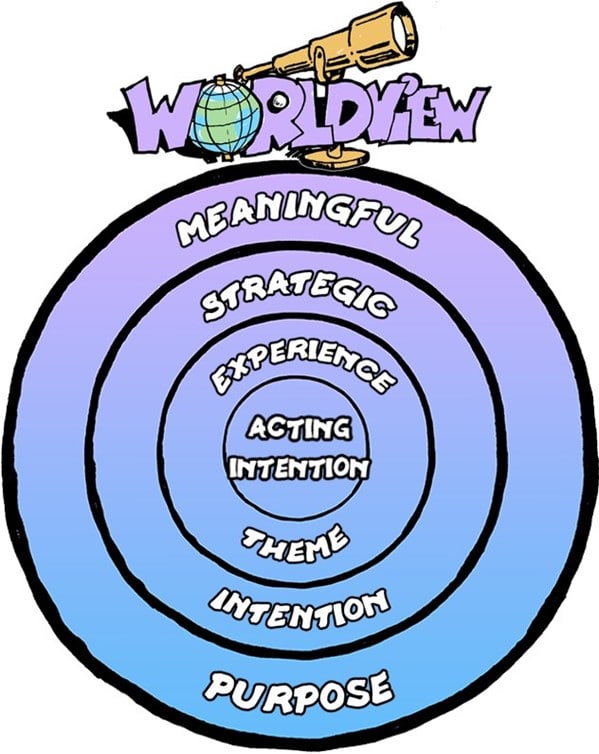In my last Thoughts post, Embrace Theatre Intentionally I wrote about how intertwined were acting and THEMEing.
Here I want to make one final connection, for these comprise the first two of five levels of intention in business, as seen in the nearby Intention Framework illustrated by Kevin Dulle.
Levels of Intention
Acting Intention
At the lowest (innermost) level is the acting intention discussed in the previous post.
These intentions make it clear to the actors on your business stage – ie, any frontline workers in front of customers, again via any and all media – how they should do what they do. (Jim Gilmore and I show how to do this in our online video training offering for frontline personnel, OnStage.)

Experience Theme
At the next higher level is the experience theme, again the organizing principle of the experience. The theme serves as a two-edged sword for determining what is in the experience and – perhaps even more important – what is out. It is the intention to which the organization puts all its experience design resources for any offering, and thereby incorporates acting intentions.
Strategic Intention
The third level of the Intention Framework is strategic intention, the change the business is trying to be in the
world.
This concept was first popularized by Gary Hamel and the late C.K. Prahalad in their 2005 Harvard Business Review article “Strategic Intent”.
After citing them in chapter 10 of The Experience Economy Jim and I go on to write (pp. 261-2):
The strategy of a business confers meaning only if those called on to execute it understand – ideally, viscerally – how the company plans to alter the very structure of the world through its industry.
Every activity of the company must be performed in order to advance external change. The firm can then fulfill its specific strategic intention not by competing for the future but by actively attaining that future. And that can only be accomplished through rigorous thinking about what business the company truly is in.
The focus of the entire book, of course, is to get people to understand the possibilities for creating greater economic value by shifting into the business of staging experiences and/or guiding transformations.
Now the (generally) medium-term strategic intention of any organization must then (always) align with its (very long-term) meaningful purpose.
The meaningful purpose is the raison d’etre of the enterprise, its reason for existence, the why the business exists beyond making money. (Making money should never be the purpose of any enterprise; rather, it is the measure of how well the enterprise fulfills its purpose.)
Purpose gives work meaning, defines why the enterprise is more than an accumulation of processes and an aggregation of employees and points workers toward a common goal.
And as we define it in chapter 7 of Authenticity: What Consumers Really Want:
Sense of Purpose = Intention + Interest
This, then, is the highest level of intention in the model.
Meaningful Purpose
I have been working with Kim Korn of Create Advantage for a number of years on his ideas on how companies can thrive forever, rather than fall into mediocrity and eventually fail.
He’s developed the concept of regenerative managing to guide enterprises in what they need to do differently to sustain and build on their competitive advantages by innovating faster than their ecosystems – the only way to ensure enduring advantage.
Core to regenerative managing is seven requirements, one of which is to pursue purpose. Effective pursuit of purpose entails an enterprise infusing meaning within all its contributors.
Kim and I believe that only a meaningful purpose constructively guides, inspires, and unifies those affiliated with, contributing to, and impacted by the enterprise.
Being both virtuous and timeless, meaningful purpose provides the only logical stability in an otherwise dynamic if not chaotic world that demands ceaseless progression in all other aspects of the enterprise.
In order for an enterprise’s purpose, manifest in the intentions of its businesses, to be
meaningful it must be declared, promulgated, upheld, and, especially, lived in a way that
it:
- Enriches greater humanity;
- Simultaneously enriches the workers within, and other contributors to, the
enterprise; - Aligns all these contributors – whether employees, volunteers, partners, or other
stakeholders – in the direction and movement of the enterprise; - Functions as a two-edged sword, determining what is in and what is out
(including who is in and who is out, as every contributor must ascend to the
proposition it makes); - Works for the people who choose to be in (whether or not those who do not join
in view it as silly, trite, or unworkable); and - Is concise, evocative, and memorable.
It also should not be a vision, mission statement, or tagline, all of which must necessarily change with changing times. A meaningful purpose should be composed to last.
As one example of this, over three decades ago Mark Scott, co-author of Courage to Be First, when the CEO of Mid-Columbia Medical Center in The Dalles, Oregon, marshaled in place a three-word purpose still operative today: Personalize. Humanize. Demystify.
Every decision made in the enterprise, from the board and CEO on down, is based on whether it better personalizes, humanizes, or demystifies the healthcare experience for its patients.
Thanks to the power of that purpose this small hospital has gone from serving two sides of the Columbia River Gorge to having patients come from over 20 states.
Worldview
You’ll note that “Worldview” lies at the top of the Intention Framework but does not make up one of its levels.
Think of it as the background for intention, for how one views the world sets the context for meaningful purpose most of all, but the other levels of intention as well.
Jim and I have long said that we’re not futurists. We don’t say what’s going to happen; we tell you what’s already happening that you do not yet see.
But we were perhaps at our most futurist when we wrote in the original edition of The Experience Economy back in 1999:
In the forthcoming Transformation Economy, aspirants will entrust their futures only to those with whom they share a common worldview.
The transformation elicitor must embrace a context for change – the values the business enterprise seeks to promote – leading eventually to companies that practice worldview segmentation.
No longer can an enterprise take an agnostic attitude toward moral rightness and wrongness, hiding from such sensitive issues beneath the cloak of mere goods and services. Consciously. . . or not, all enterprises promote a worldview.
Transformation issues cannot be avoided. Extracted commodities transform the earth into a subdued planet, with implications for all its inhabitants.
Goods transform buyers into users of those goods, for ill or for gain. Services transform clients into recipients of those services, whether debasing or edifying.
Experiences transform guests into participants in the encounter, whether the long-term effects are deleterious or therapeutic.
And transformations turn aspirants into “a new you,” with all the ethical,philosophical, and religious implications that phrase implies. All commerce involves moral choice.
That is exactly what we see happening today.
So what is the worldview underlying your business? How can you create, promulgate, and enculturate a meaningful purpose into your enterprise? How can you bring that purpose alive through each of the levels of the Intention Framework?
And, finally, now that you understand all this, what do you intend to do about it?



